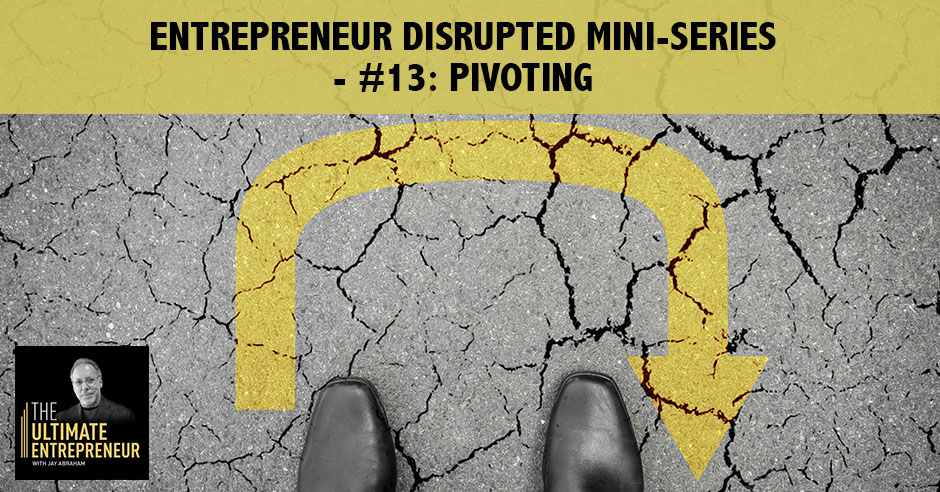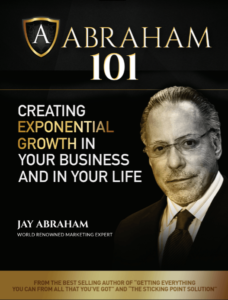Entrepreneur Disrupted Mini-Series – #13: Pivoting


Is pivoting in business still necessary? It’s an issue that every company, no matter the industry, faces – the need to pivot. Oftentimes, companies come across an obstacle they see no way around and think their only option is a dramatic pivot – laying off half the team, dramatic changes to company structure, going into panic mode to save they’ve worked so hard to build. Are we reaching an era of more flexible companies where pivots become meaningless because we change on a daily, weekly or monthly basis to meet the market’s needs?
It can be argued that a company that’s well-built doesn’t pivot at all because it’s fluid. Fluid companies have the ability to navigate a much more rapidly changing terrain and change their strategy quickly, but in a way that’s not traumatic to the company. You don’t have to lay off half of the company. In #13 of Entrepreneur Disrupted, Dave Asprey and Jay Abraham explain why a fluid business is actually better than a business that pivots. Learn from real life examples as Dave and Jay share their own perspectives and approaches on how to integrate these factors into your business.
Listen to the podcast here:
Entrepreneur Disrupted Mini-Series – #13: Pivoting
This episode is an issue that every entrepreneur and your company, no matter the size or the industry, sooner or later faces: Pivoting. Dave and I tackle it in a very disruptive manner. Do companies need a pivot in the first place? Oftentimes, companies come across an obstacle that they see no way around and they think their only option is a dramatic pivot. Laying off half the team, dramatic changes to company structure, strategy, business model and going into panic mode to save what they’ve worked so hard to build. What we address here is whether or not this needs to be an issue in the first place. We answer exactly what a pivot is, when it is genuinely needed, and whether it’s needed in the first place, and why. We go into why fluid business is better than a business that pivots. David and I share our own perspectives and approaches on integrating these factors into our own businesses, so you can see real life examples. I hope you do what is essential to your own business aspirations and take meaningful action from the wisdom, advice, and illustrations we’ve distilled in this episode.
We are here to help you solve some business problems. We’re going to talk about when to pivot. When you’re running a company, there’s this idea about what is the pivot, and when do you pivot. Jay said that a lot of companies pivot two or three times, but what is a pivot? When you change models, a perspective that’s worth considering as entrepreneurs is what happens when it’s a small pivot? My background in software and even hardware in Silicon Valley is that you might get changed to a usage-based pricing. You might change business models in a meaningful way, but what if you make a radical change in your product strategy? Is that considered a pivot? I would argue that a company that’s well-built doesn’t pivot at all because it’s fluid. It has the ability to navigate a much more rapidly changing terrain so that you can change strategy relatively quickly, but it’s not traumatic to the company. You don’t have to lay off half of the company. What do you think about it, Jay? Are we reaching an era of more flexible companies where pivots become meaningless because we change on a daily, weekly or monthly basis to meet the market’s needs?

Pivoting In Business: Flexibility is inherent in flying, and it’s inherent in achieving flying, figuratively.
You caught me intellectually off-guard. I agree with you and you’re right. A pivot to me represents a lot of different elements. They should always be experimenting with new markets, new messages, new products, new services, and new channels. I was on the first 747 SP400, which was long range. When it took off, it almost didn’t make it off the runway because it weighed a couple of million pounds. What was more interesting is that I was on the wing and I never noticed that the wing flexes twenty feet. I was with the pilot and I said, “This scares me.” He said, “If it didn’t flex, the first time you hit turbulence, it would snap off and fall to the ground.” Flexibility is inherent in flying, and it’s inherent in achieving flying, figuratively. The moment you start, you’ve got to know what your purpose is. The purpose can manifest and it will morph. It doesn’t morph, you grow or you die. That’s applicable to a business, to product model and market, because no one and nothing stays constant.
Part of pivoting is being ready. It’s building that flexibility into the company. The way I look at doing this is there’s advanced R&D, if you’re a product company. You think the market is going in this direction, but you have these other side projects that may become important, and you want to be experimenting with different models all the time. Is it a pivot if it’s not done out of desperation or because something isn’t working, but just because you found something that works better? I look at what I’m doing with Bulletproof. I’ve got a content business, we’ve got Bulletproof Radio, which is becoming a very substantial show. We’ve got a coaching business, we’ve got retail coffee shops, we’ve got wholesale distribution, and we’ve got e-commerce. Did I pivot? No. I’m testing all the viable models I can think of at the same time, and running them concurrently, which is much more like something you would do in a software company.
One group of business people would say, “Dave, you’re probably stressing your team out. You’re doing all sorts of things. You’re a classical ADD entrepreneur.”The other part of me says, “I don’t know which of those is going to work best. I know that I’m good at creating content that’s meaningful, and I know that I’m good at making products that work, but I don’t know how important is grocery distribution. Until I try it, I don’t know.” Can I hire A-players? I can, but I don’t know whether next year, 80% of our business is going to be in grocery stores, or is going to be on e-commerce, but I’m okay with either one.
But you’re not betting the farm on either one.
I’m betting the farm that one of the two is going to go.
You stimulated six fast thoughts. First, probably and implicitly, most big corporations have teams that continually do intelligence gathering. They check analysis. They look for what they’re doing better, different markets, products, and services. They look at alternative means of providing the same result, but not in that industry. They look at what else is out there. They look deeply at what the buyers are saying, whether good and bad, about the direct competitors in the indirect competitors, and they are constantly testing. We talked about the pharmaceutical industry. It may have cut down, but they spend 20% of their revenue trying to find one drug, and they lose 98%. Most entrepreneurs, the most disruptive thing you can tell them to do vis-à-vis whatever pivoting is you should make a constant commitment. Allocate a portion of your revenue profit, however you do, each and every month to testing different assumptions. The application of those tests are up to you. You want to test different markets, different products, product propositions that you find somewhere else to fulfill on, different segments of groups, different lead generating products, different extension products or different distribution channels. If you’re not committed to constantly asking those questions and then knowing how to not just act on it, but how to immobilize the most productive pro-action on it, you’re going to stagnate.
It comes down to the F word, fear. Most entrepreneurs including me some of the time think, “Do I really want to try and do this?” A good number of people have said, “Dave, you have a great e-commerce thing going with Bulletproof. Why would you ever run a grocery or even go and make a coffee shop, which is expensive?” I said, “The mission here is to get a lot of people to try Bulletproof Coffee, because it changes the quality of their day. It’s a product that works and I believe I’m doing greater good by turning people’s brains on more.” That thinking, where the goal was maximum reach, not necessarily maximum profit right now, that’s part of our mission. From a business model perspective that could be expensive. I may be disrupting my own business by going into wholesale, but the value seems there, and you get resilience in the business when you have two distribution channels. For me, overcoming the fear was straight forward. I’ve done a lot of the hard work around why do I feel the fear response.
When it comes to making changes in the business, to experiment with the business, and calling it a pivot or saying, “We have multiple irons in the fire. We’re going to see which iron gets hot fastest, and we’ll put more coal on that fire.” To do that as the head guy, it takes a lot of introspection and to say, “I’m going to do this. We might lose half a million dollars on this project, but if it goes, we might make a lot.” If you’re at an early-stage startup, you don’t have $5,000 to lose. That’s when it moves from fear to almost a terror because you’re like, “I just quit my job, I have x amount of money. If I don’t get a hit, I have to get another job.” Then you hit the other F word, which is failure, and fear of failure. What’s your advice for people both new and everything’s on the table, and then people who are halfway through, who’s still afraid they’re going to wreck something that’s got value now?
The key to experimentation is to learn that if you can’t get things that are totally definitive, you can at least get indicative results very inexpensively, and you can extrapolate, or you can go higher. There are ways to utilize other people’s resources when you have no money. One of my friends said that most people in business, when they’re either very excited or very stressed, they dig holes. The more excited or stressed, the faster the holes, but they never stop and say, “First of all, should I be digging a hole?”If the answer is yes, “Should I be digging it there?” If the answer is yes, “Should I be digging it with a spoon or a power trowel?” If the answer is yes, “Should I be the one running it?” We should prepare a very easy matrix of factors, elements, forces, and impact points that need to be evaluated constantly so you know whether you need to be focused on dynamic strategic management.
If you’re 35 years old and have a family and you got a little bit in the bank but not enough to retire and you’re like, “I’m going to go out on my own.” How do I deal when I don’t know if I’ve got the right model or if I’m going to have to pivot? Things like that fear of testing multiple things.

Abraham 101: Creating Exponential Growth In Your Business and In Your Life
I did something for Peter Thiel’s fellowship and they all wanted to know, “How do I get Co-Founders? How do I get people to give us office space? How do I get people to fund the next level of my research?” I did a treatise on that but more importantly, I have two books on that. One is called Abraham 101. It’s foundational of how to build a business with the least amount of time, effort and risk. The other was originally titled How to Get the Money for Your New Idea or Startup and What to Do If You Can’t. The biggest flaw that exists in new or stuck entrepreneurs is that they are not willing to commit the time to grow up. Jeffrey Gitomer who is well-known in sales training, he could be very shocking both with his vocabulary and with his straightforwardness. He was dealing with my audience and he was talking about, “Why are you watching re-runs of CSI when you could be investing the most precious thing you’ve got, the cumulative amount of time it would make in growing you?” The average person reads four books a year when knowledge, technology, methodology and market demand is growing, shifting, expanding and transforming. We are arrogant and ignorant enough to think that all we have to do is dig more holes. It’s an embarrassing mindset. The first thing is you need to be alone with yourself and look in the mirror and point, and you’ll see who the biggest culprit usually is in your life.
That is true of every single entrepreneur that I’m friends with or worked with it. It all comes down to that thing that comes out of you as an entrepreneur. The answer for the question, “When to pivot?” is every day in every way, which may be an overwhelming feeling, but it’s okay. Most entrepreneurs feel overwhelmed until they adjust their nervous systems to realize that you don’t have to feel overwhelmed when there’s a lot going on. There are different things. You realize, “There’s way more going on that I’m going to act on right now,” but you can do that without the traumatic feelings happening there. That’s what allows you to build a company that’s flexible. If you can’t do that and your team can’t do that, then you have issues. That comes down to dealing with fear and failure on a personal level and making it part of the team. We have some calls where we celebrate failure at Bulletproof, where I’m doing everything I can to build it into the culture and say, “It’s okay to fail. It’s not okay to fail the same way twice, and if you fail all the time, you’re probably out of here. If we all agreed that we were going to do something and we put someone in-charge of it and they went out and they did it and it was an absolute and complete failure, what do we do?” As long as they executed the failure, if you can do that, you can pivot.
I come from an era where if you had a car, you hoped you checked the oil because when it ran out, the engine froze. It just didn’t have good monitoring. Now, it’s all self-diagnosed and adjusts every day. You need to be able to learn to look not just at hard data, because many of the fluid and dynamic areas of the business you need to review on a continuous basis are soft but they’re very critical.
Important Links:

